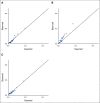Development and Validation of the PREMMplus Model for Multigene Hereditary Cancer Risk Assessment
- PMID: 35960913
- PMCID: PMC9746785
- DOI: 10.1200/JCO.22.00120
Development and Validation of the PREMMplus Model for Multigene Hereditary Cancer Risk Assessment
Abstract
Purpose: With the availability of multigene panel testing (MGPT) for hereditary cancer risk assessment, clinicians need to assess the likelihood of pathogenic germline variants (PGVs) across numerous genes in parallel. This study's aim was to develop and validate a clinical prediction model (PREMMplus) for MGPT risk assessment.
Materials and methods: PREMMplus was developed in a single-institution cohort of 7,280 individuals who had undergone MGPT. Logistic regression models with Least Absolute Shrinkage and Selection Operator regularization were used to examine candidate predictors (age, sex, ethnicity, and personal/family history of 18 cancers/neoplasms) to estimate one's likelihood of carrying PGVs in 19 genes (broadly categorized by phenotypic overlap and/or relative penetrance: 11 category A [APC, BRCA1/2, CDH1, EPCAM, MLH1, MSH2, MSH6, biallelic MUTYH, PMS2, and TP53] and eight category B genes [ATM, BRIP1, CDKN2A, CHEK2, PALB2, PTEN, RAD51C, and RAD51D]). Model performance was validated in nonoverlapping data sets of 8,691 and 14,849 individuals with prior MGPT ascertained from clinic- and laboratory-based settings, respectively.
Results: PREMMplus (score ≥ 2.5%) had 93.9%, 91.7%, and 89.3% sensitivity and 98.3%, 97.5%, and 97.8% negative-predictive value (NPV) for identifying category A gene PGV carriers in the development and validation cohorts, respectively. PREMMplus assessment (score ≥ 2.5%) had 89.9%, 85.6%, and 84.2% sensitivity and 95.0%, 93.5%, and 93.5% NPV, respectively, for identifying category A/B gene PGV carriers. Decision curve analyses support MGPT for individuals predicted to have ≥ 2.5% probability of a PGV.
Conclusion: PREMMplus accurately identifies individuals with PGVs in a diverse spectrum of cancer susceptibility genes with high sensitivity/NPV. Individuals with PREMMplus scores ≥ 2.5% should be considered for MGPT.
Conflict of interest statement
Development and Validation of the PREMMplus Model for Multigene Hereditary Cancer Risk Assessment
The following represents disclosure information provided by authors of this manuscript. All relationships are considered compensated unless otherwise noted. Relationships are self-held unless noted. I = Immediate Family Member, Inst = My Institution. Relationships may not relate to the subject matter of this manuscript. For more information about ASCO's conflict of interest policy, please refer to
Open Payments is a public database containing information reported by companies about payments made to US-licensed physicians (
Figures


Comment in
-
Who Should Have Multigene Germline Testing for Hereditary Cancer?J Clin Oncol. 2022 Dec 10;40(35):4040-4043. doi: 10.1200/JCO.22.01691. Epub 2022 Sep 27. J Clin Oncol. 2022. PMID: 36166722 Free PMC article. No abstract available.
Similar articles
-
Pathogenic germline variants in cancer predisposition genes in patients with multiple primary cancers in an Asian population and the role of extended panel genetic testing.ESMO Open. 2025 Mar;10(3):104495. doi: 10.1016/j.esmoop.2025.104495. Epub 2025 Mar 10. ESMO Open. 2025. PMID: 40068381 Free PMC article.
-
Prevalence of Pathogenic Germline Variants in Patients With Gastric Cancer Ascertained Through Multigene Panel Testing.JCO Precis Oncol. 2025 Jun;9:e2400620. doi: 10.1200/PO-24-00620. Epub 2025 Jun 4. JCO Precis Oncol. 2025. PMID: 40466029
-
Pathogenic variants among females with breast cancer and a non-breast cancer reveal opportunities for cancer interception.Breast Cancer Res Treat. 2023 Jul;200(1):63-72. doi: 10.1007/s10549-023-06870-x. Epub 2023 Mar 1. Breast Cancer Res Treat. 2023. PMID: 36856935 Free PMC article.
-
Recommendations for Preventive Care for Women with Rare Genetic Cause of Breast and Ovarian Cancer.Klin Onkol. 2019 Summer;32(Supplementum2):6-13. doi: 10.14735/amko2019S6. Klin Onkol. 2019. PMID: 31409076 Review. English.
-
Moderate penetrance genes complicate genetic testing for breast cancer diagnosis: ATM, CHEK2, BARD1 and RAD51D.Breast. 2022 Oct;65:32-40. doi: 10.1016/j.breast.2022.06.003. Epub 2022 Jun 18. Breast. 2022. PMID: 35772246 Free PMC article. Review.
Cited by
-
Comparison of PREMM5 and PREMMplus Risk Assessment Models to Identify Lynch Syndrome.JCO Precis Oncol. 2025 Jan;9:e2400691. doi: 10.1200/PO-24-00691. Epub 2025 Jan 7. JCO Precis Oncol. 2025. PMID: 39772830
-
Genomics and integrative clinical data machine learning scoring model to ascertain likely Lynch syndrome patients.BJC Rep. 2025 May 5;3(1):30. doi: 10.1038/s44276-025-00140-7. BJC Rep. 2025. PMID: 40325286 Free PMC article.
-
Who Should Have Multigene Germline Testing for Hereditary Cancer?J Clin Oncol. 2022 Dec 10;40(35):4040-4043. doi: 10.1200/JCO.22.01691. Epub 2022 Sep 27. J Clin Oncol. 2022. PMID: 36166722 Free PMC article. No abstract available.
-
Lynch syndrome cancer vaccines: A roadmap for the development of precision immunoprevention strategies.Front Oncol. 2023 Mar 22;13:1147590. doi: 10.3389/fonc.2023.1147590. eCollection 2023. Front Oncol. 2023. PMID: 37035178 Free PMC article. Review.
-
A multi-omics analysis-based model to predict the prognosis of low-grade gliomas.Sci Rep. 2024 Apr 24;14(1):9427. doi: 10.1038/s41598-024-58434-8. Sci Rep. 2024. PMID: 38658591 Free PMC article.
References
Publication types
MeSH terms
Grants and funding
LinkOut - more resources
Full Text Sources
Medical
Research Materials
Miscellaneous

